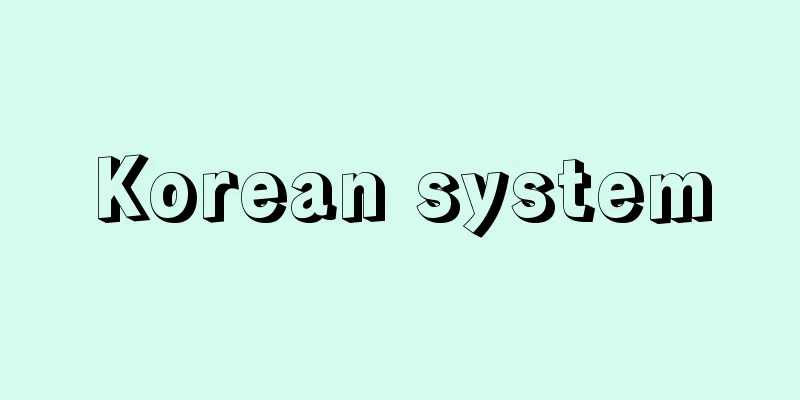Distribution channel - Ryutsukeiro

|
The route that goods follow from production to consumption. The circulation of goods in modern society consists of three processes: production, distribution, and consumption. Goods pass through this distribution process, from producer to consumer, and are ultimately consumed. It is generally more efficient for producers to have a distribution process in between and have distributors intervene in their trading activities, rather than selling directly to consumers. Various goods flow through this distribution process, mediated by various distributors, to the consumer, and this route is called a distribution channel. When distribution channels are viewed as a system from a national economic standpoint, they are called distribution mechanisms, and when individual producers exert some kind of control over the distribution channel, they are called sales channels. [Hiroshi Nomura] Diverse FormsDistribution channels take a variety of forms depending on the characteristics of the product, the business practices of the industry, the policies and scale of the producers and distributors, the distance of logistics, and other factors. In a typical distribution channel for a product, the suppliers are producers and importers, and the consumers are individual consumers, industrial users, and exports. Products flow from top to bottom between these groups, and generally pass through two or three levels of wholesalers and retailers along the way. The reason distributors such as wholesalers and retailers exist between producers and consumers is that distributors can use their specialized technology to handle the products of many producers in a concentrated manner, thereby reducing transaction and logistics costs and shortening the sales period of products. As a result, distribution becomes cheaper and more efficient than if the producers were to sell directly. Distributors include retailers who sell directly to consumers, and wholesalers who act as intermediaries between producers and retailers. Furthermore, wholesalers usually have two or three hierarchical groups, each with its own division of labor. First, there are original wholesalers who deal directly with producers, then final wholesalers who sell to retailers, and often intermediate wholesalers are in between these two. From a functional perspective, original wholesalers are in charge of assembling products from many producers, intermediate wholesalers are in charge of relaying them to final wholesalers, and final wholesalers are in charge of distributing them to many retail stores. In the case of everyday consumer goods targeted at individual consumers, original wholesalers are concentrated in big cities such as Tokyo and Osaka, intermediate wholesalers are located in core cities in each region of the country, and final wholesalers are often distributed in the central cities of each prefecture. Therefore, the distribution of goods does not only flow vertically through the division of labor between distributors, but also disperses geographically widely from big cities to the countryside, prefectures, and municipalities. However, not all products follow this distribution route. Some products are distributed directly from producers to consumers, for example through mail order sales, and wholesalers at each stage may sell directly to consumers. Also, industrial users, who consume raw materials and machinery equipment for factories, tend to purchase directly from wholesalers at each stage rather than from retailers, as their usage and transaction value is large. Sometimes they purchase directly from producers. Perishable foods such as fruits and vegetables have a special distribution route, since there are many farmers who produce them and many individuals who consume them. Fruits and vegetables are first collected by general or specialized agricultural cooperatives, or collection markets in the production area, and then sent to central or local markets in the consumption area. They then pass through the hands of wholesalers and middlemen at the market before being put on display at retail stores. [Hiroshi Nomura] Rationalization of distributionEfforts have been made for a long time to simplify these complicated distribution channels and streamline them in order to further improve distribution efficiency and reduce distribution costs. The main characteristics of the current changes in distribution channels are as follows: The first is the impact that the systematization of distribution has had on distribution channels. It is a movement to break down the division of labor between producers, wholesalers at each stage, and retailers who share the same distribution channel, and to vertically integrate it. In this case, a specific company belonging to one of the stages of the distribution channel becomes the conductor of the entire distribution channel, and the companies at each stage become its members, and a vertical distribution system is constructed. From the standpoint of an individual company as a system conductor, it grasps the distribution channel of its own product as a system and tries to optimize the relationship between the necessary costs and their effects. In many cases, large companies that are producers were the conductors, but as a result of deregulation of distribution, there has been a progress in systematization from the bottom up, with the development of large-scale retail stores by large capital and the establishment of convenience stores with franchises or voluntary systems. These two types of systematization seem to be contradictory at first glance, but in reality, they have a considerable amount in common in terms of ensuring stable sales prices and sales volume. In particular, deregulation of distribution has accelerated this trend with the development of large-scale suburban stores that rely on customers who drive their own cars. The second is the impact of the systematization of the logistics routes that accompany the distribution routes of each product. Previously, various logistics activities such as product ordering, packaging, storage, sorting, and delivery were separate, but now they are controlled by logistics information systems using computers, especially online systems, and progress is being made in building a single, accurate, fast, and efficient comprehensive logistics system. As a result, the distribution route, which is the route by which the ownership of products is transferred, and the logistics route, which is the physical movement of products, are separated (separation of goods and commerce), and a simple, highly efficient logistics system is in operation that is separate from multi-stage distribution routes. The third is the emergence of a new distribution channel known as direct marketing or non-store sales, which links producers and consumers more directly. Mail order companies, large retailers, delivery companies, agricultural cooperatives, and fishery cooperatives use television commercials, catalogs, the Internet, and other methods to sell directly to consumers using delivery services, without going through stores. Fruits and vegetables, fresh fish and shellfish, electrical appliances, clothing, and local specialty products are all handled through these channels. [Hiroshi Nomura] "Seminar Introduction to Distribution" edited by Yoshihiro Tajima and Hideo Harada (1997, Nihon Keizai Shimbun) " "Introduction to Modern Distribution" edited by Yoshitada Kato, Masamichi Saito, and Yasuyuki Sasaki (2007, Yuhikaku) [References] | | | | | |©Shogakukan "> Distribution channels (general product distribution channels) Source: Shogakukan Encyclopedia Nipponica About Encyclopedia Nipponica Information | Legend |
|
生産から消費に至るまでに商品がたどる経路のこと。現代社会における商品の循環は、生産過程、流通過程そして消費過程の三つの過程によって構成されている。商品は、この流通過程を経て、生産者から消費者にわたり、最終的に消費される。生産者が消費者に直接販売するよりは、その間に流通過程を置いて流通業者の取引活動を介入させたほうが、一般に効率的なのである。各種商品はこの流通過程のなかで種々な流通業者に媒介され消費者まで流れていく、この流れの道筋を流通経路という。流通経路を国民経済的立場から仕組みとしてとらえるとき流通機構とよばれ、また個別生産者が流通経路になんらかの統制を加える場合に販売経路とよばれる。 [野村 宏] 多様な形態流通経路は、商品の特性、業界の商慣習、生産者および流通業者の政策・規模、物流の距離などによって多様な形態をもつ。典型的な商品の流通経路には、供給者として生産者および輸入業者があり、消費者として個人消費者、産業用使用者および輸出がある。商品はこれらの間を上から下に流れるのであるが、その過程で2ないし3段階の卸売業者層、および小売業者の手を経るのが一般的である。生産者と消費者の間に卸売業者や小売業者などの流通業者が介在する理由は、流通業者がその専門技術を駆使し、多くの生産者の商品を集約的に取り扱うことによって、取引費用および物流費用を圧縮し、かつ商品の販売期間を短縮できるからである。その結果、生産者が直接販売するよりも、低コストで、かつ効率的な流通が可能となる。 流通業者には、直接消費者への販売を担当する小売業者と、生産者と小売業者との間を仲介する卸売業者がある。さらに、卸売業者には通常2ないし3階層のグループがあり、それぞれが分業関係をもっている。まず、生産者に直接対応する元卸業者、ついで、小売業者に販売する最終卸業者があり、さらにこれらの中間に中間卸業者が介在することが多い。それを機能面からみれば、元卸業者は多くの生産者から商品を集約する品ぞろえ機能を担当し、中間卸業者はそれを最終卸業者に中継する機能を担当し、最終卸業者は数多くの小売店へ分散させるという機能を担当している。個人消費者を対象とする日常消費財などの場合には、元卸業者は東京・大阪などの大都市に集中しており、中間卸業者は全国各地方の中核都市に立地し、さらに最終卸業者は各県の中心都市に分布していることが多い。したがって、商品の流通は流通業者間の分業関係のなかを縦に流れるだけでなく、大都市から地方、各県、そして各市町村へと地理的にも広く分散していくことになる。 しかし、すべての商品がこのような流通経路をたどるとは限らない。一部の商品では、たとえば通信販売のように生産者から直接に消費者に流通するし、各段階の卸売業者が直接消費者に販売することもある。また、工場用の原材料や機械設備などの消費者である産業用使用者は、その使用量や取引額が大きいので、小売業者からではなく、各段階の卸売業者から直接購入することが多い。ときには生産者から直接購入する場合もある。青果物のような生鮮食品にあっては、生産者である農家の数が多く、また、消費者が多数の個人であるために、特殊な流通経路をもっている。青果物はまず総合・専門農業協同組合、あるいは生産地集荷市場に集められ、次に消費地の中央市場・地方市場に送られる。そして市場の卸売業者・仲買人の手を経て、小売店頭に並べられる。 [野村 宏] 流通の合理化こうした複雑な流通経路を簡素化し、いっそうの流通効率向上と流通経費削減を目的とする流通合理化の努力が長期間重ねられている。現在における流通経路の変化の主要な特徴をあげると、次の三つがある。 第一は、流通のシステム化が流通経路に与えた影響である。流通経路を同じくする生産者、各段階の卸売業者そして小売業者という分業関係を崩し、それを垂直的に統合しようとする動きである。この場合、流通経路のいずれかの段階に属する特定企業が流通経路全体のコンダクターとなり、各段階の諸企業をその構成員とし、一つの垂直的流通システムを構築するという形をとる。それはシステム・コンダクターとしての個別企業の立場から、自己の商品の流通経路を一つのシステムとして把握し、それに必要な費用とその効果の関係を最適にしようとするものである。多くの場合は、生産者である大手企業がコンダクターとなっていたが、流通の規制緩和の結果、大資本による大規模小売型店舗の展開やフランチャイズあるいはボランタリー制をとるコンビニエンス・ストアの定着などによる下からのシステム化の進行がある。これら両者のシステム化は一見矛盾するようにみえるが、実際には、販売価格の安定性や販売量の確保という点で、相当程度の共通点をもっている。とくに流通の規制緩和は、マイカー顧客に依存する郊外型大規模店舗の展開で、この傾向に拍車をかけている。 第二は、各商品の流通経路に随伴する物流経路に関するシステム化の影響である。従来、ばらばらであった商品の受発注・包装・保管・仕分け・配送などの諸物流活動を、コンピュータ、とくにオンラインなどを利用した物流情報システムによって統御し、正確、迅速、かつ効率的な一つの総合的物流システムの構築が進められている。その結果、商品の所有権移動の道筋としての流通経路と、商品の物理的移動としての物流経路が分離され(商物分離)、多段階的な流通経路から切り離された単純、かつ高水準で効率的な物流システムが活動する。 第三は、ダイレクト・マーケティングあるいは無店舗販売といわれる生産者と消費者をより直接的に結び付ける新しい流通経路の出現である。通販業者、大型小売店、宅配業者そして農協・漁協などが、テレビ・コマーシャルやカタログ、インターネットなどを利用して、店舗を経由せず、宅配便を利用し直接消費者へ販売するケースがそれである。そこでは青果物、生鮮魚介類、電化製品、衣料品そして各地の特産品などが取り扱われている。 [野村 宏] 『田島義博・原田英生編著『ゼミナール流通入門』(1997・日本経済新聞社)』▽『加藤義忠・齋藤雅通・佐々木保幸編『現代流通入門』(2007・有斐閣)』 [参照項目] | | | | | |©Shogakukan"> 流通経路(一般商品の流通経路) 出典 小学館 日本大百科全書(ニッポニカ)日本大百科全書(ニッポニカ)について 情報 | 凡例 |
<<: Distribution tax - Ryutsuuzei
Recommend
Flower bed - Kadan
It refers to the arrangement of annual and bienni...
Wartime Law - Senjiho
The meaning of wartime legislation is not necessar...
Lewis and Clark Expedition
Led by Meriwether Lewis and William Clark, this ex...
Forsythia suspensa; goldenbell
A deciduous shrub of the Oleaceae family. It is al...
Wittig, G.
…Metal hydrides, such as lithium aluminum hydride...
Single
…After the Renaissance, in Belgium, the Netherlan...
Dainihon Butokukai - Dainihon Butokukai
On April 17, 1895 (Meiji 28), as part of the comm...
San Juan Bautista (English spelling)
...The city is the core of an agricultural region...
Anaerobics
Anaerobic exercise is also called anaerobic exerci...
International Institute of Communications
…Headquarters: Costa Rica. International Institut...
Perovskite (English spelling)
A type of double oxide mineral. It is also called...
Montserrat (mountain) (English spelling)
A mountain in the province of Barcelona in the Cat...
Nagatsuka Tomb
This keyhole-shaped tumulus is located in Gongenma...
Wilson, W.
…In 1869, underwater football was played in Engla...
Buffing compound - Buffing compound
An abrasive used for medium polishing (rough polis...









